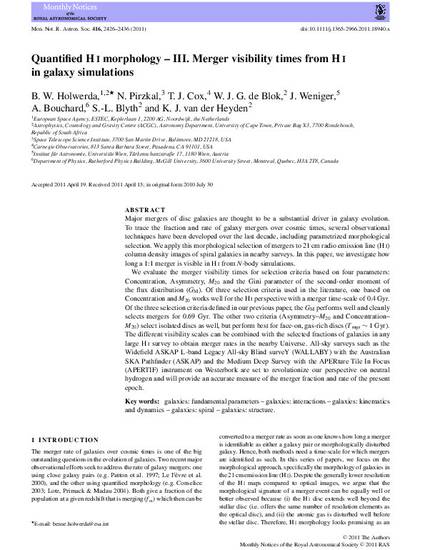
Major mergers of disc galaxies are thought to be a substantial driver in galaxy evolution. To trace the fraction and rate of galaxy mergers over cosmic times, several observational techniques have been developed over the last decade, including parametrized morphological selection. We apply this morphological selection of mergers to 21 cm radio emission line (H I) column density images of spiral galaxies in nearby surveys. In this paper, we investigate how long a 1:1 merger is visible in H I from N-body simulations. We evaluate the merger visibility times for selection criteria based on four parameters: Concentration, Asymmetry, M20 and the Gini parameter of the second-order moment of the flux distribution (GM). Of three selection criteria used in the literature, one based on Concentration and M20 works well for the H I perspective with a merger time-scale of 0.4 Gyr. Of the three selection criteria defined in our previous paper, the GM performs well and cleanly selects mergers for 0.69 Gyr. The other two criteria (Asymmetry–M20 and Concentration– M20) select isolated discs as well, but perform best for face-on, gas-rich discs (Tmgr ∼ 1 Gyr). The different visibility scales can be combined with the selected fractions of galaxies in any large H I survey to obtain merger rates in the nearby Universe. All-sky surveys such as the Widefield ASKAP L-band Legacy All-sky Blind surveY (WALLABY) with the Australian SKA Pathfinder (ASKAP) and the Medium Deep Survey with the APERture Tile In Focus (APERTIF) instrument on Westerbork are set to revolutionize our perspective on neutral hydrogen and will provide an accurate measure of the merger fraction and rate of the present epoch.
Holwerda, B. W., et al. "Quantified H I Morphology – III. Merger Visibility Times from H I in Galaxy Simulations." 2011. Monthly Notices of the Royal Astronomical Society 416(4): 2426-2436.

This article has been accepted for publication in Monthly Notices of the Royal Astronomical Society Copyright: 2011. Published by Oxford University Press on behalf of the Royal Astronomical Society. All rights reserved.
https://doi.org/10.1111/j.1365-2966.2011.18940.x